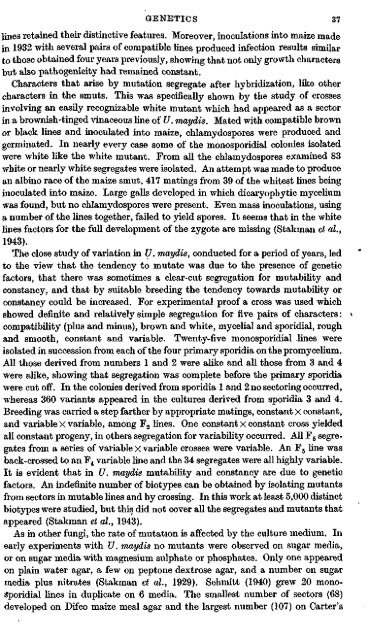nmm sP
nmm sP
nmm sP
You also want an ePaper? Increase the reach of your titles
YUMPU automatically turns print PDFs into web optimized ePapers that Google loves.
GENETICS 37<br />
lines retained their distinctive features. Moreover, inoculations into maize made<br />
in 1932 with several pairs of compatible lines produced infection results similar<br />
to those obtained four years previously, showing that not only growth characters<br />
but also pathogenicity had remained constant.<br />
Characters that arise by mutation segregate after hybridization, like other<br />
characters in the smuts. This was specifically shown by the study of crosses<br />
involving an easily recognizable white mutant which had appeared as a sector<br />
in a brownish-tinged vinaceous line of U. maydis. Mated with compatible brown<br />
or black lines and inoculated into maize, chlamydospores were produced and<br />
germinated. In nearly every case some of the monosporidial colonies isolated<br />
were white like the white mutant. From all the chlamydospores examined 83<br />
white or nearly white segregates were isolated. An attempt was made to produce<br />
an albino race of the maize smut, 417 matings from 39 of the whitest lines being<br />
inoculated into maize. Large galls developed in which dicaryophytic mycehum<br />
was found, but no chlamydospores were present. Even mass inoculations, using<br />
a number of the hnes together, failed to yield spores. It seems that in the white<br />
lines factors for the fuU development of the zygote are missing (Stakman et al.,<br />
1943).<br />
The close study of variation in U. maydis, conducted for a period of years, led<br />
to the view that the tendency to mutate was due to the presence of genetic<br />
factors, that there was sometimes a clear-cut segregation for mutability and<br />
constancy, and that by suitable breeding the tendency towards mutabiUty or<br />
constancy could be increased. For experimental proof a cross was used which<br />
showed definite and relatively simple segregation for five pairs of characters:<br />
compatibility (plus and minus), brown and white, mycelial and sporidial, rough<br />
and smooth, constant and variable. Twenty-five monosporidial lines were<br />
isolated in succession from each of the four primary sporidia on the promycelium.<br />
All those derived from numbers 1 and 2 were alike and aU those from 3 and 4<br />
were ahke, showing that segregation was complete before the primary sporidia<br />
were cut off. In the colonies derived from sporidia 1 and 2 no sectoring occurred,<br />
whereas 360 variants appeared in the cultures derived from sporidia 3 and 4.<br />
Breeding was carried a step farther by appropriate matings, constant X constant,<br />
and variable X variable, among F2 lines. One constant x constant cross yielded<br />
all constant progeny, in others segregation for variability occurred. All F5 segregates<br />
from a series of variable X variable crosses were variable. An F5 hue was<br />
back-crossed to an F4 variable line and the 34 segregates were all highly variable.<br />
It is evident that in U. maydis mutabihty and constancy are due to genetic<br />
factors. An indefinite number of biotypes can be obtained by isolating mutants<br />
from sectors in mutable hnes and by crossing. In this work at least 5,000 distinct<br />
biotypes were studied, but this did not cover all the segregates and mutants that<br />
appeared (Stakman et al., 1943).<br />
As in other fungi, the rate of mutation is affected by the culture medium. In<br />
early experiments with U. maydis no mutants were observed on sugar media,<br />
or on sugar media with magnesium sulphate or phosphates. Only one appeared<br />
on plain water agar, a few on peptone dextrose agar, and a number on sugar<br />
media plus nitrates (Stakman et al., 1929). Schmitt (1940) grew 20 monosporidial<br />
lines in duplicate on 6 media. The smallest number of sectors (68)<br />
developed on Difco maize meal agar and the largest number (107) on Carter's

















